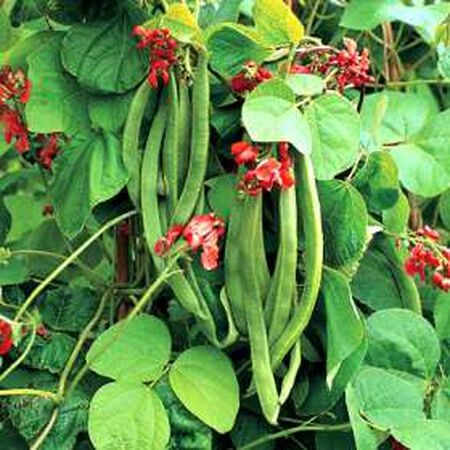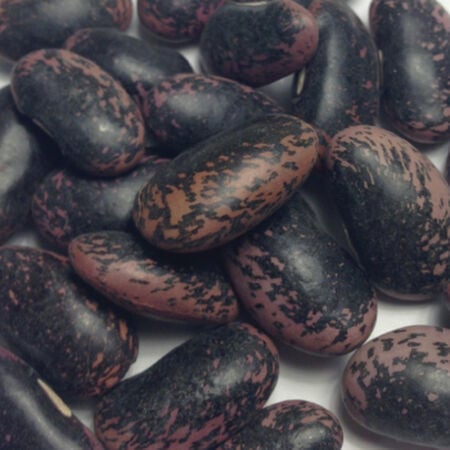Scarlet Runner, Bean Seeds
Key Attributes
Product Details
Weight
0.0625Depth
0.5Height
4.5Width
3.25Plant Height
10-20'Botanical Name
Phaseolus coccineusSeed Type
SeedAdditional Characteristics
Trellis GardenSeeds Per Gram
2Seeds Per Pound
1,100Row Spacing
3'Packet
70 SeedsSow Depth
1"Bean Seed Color
Brown,Speckled,BlackSeeds Per Ounce
69Fruit Color
GreenBreed
Open-pollinatedSun
Full SunTypes
Snap Beans, Stringless BeansMaturity
Main SeasonLife Cycle
AnnualSow Method
Direct SowPlant Spacing
3"Categories
BeanGermination
11,12,13,14,6,7,8,9,10Days To Maturity (# Days)
60Heirloom
HeirloomSeeds Per Acre
42 lbsComponents
Growing Instructions
![]() Learning Download: How to Grow Beans
Learning Download: How to Grow Beans
Beans are referred to as a number of names including snap beans, string beans and green beans. Known as being one of the more productive garden crops, they are a warm weather favorite that can be eaten straight from the garden.
Before Planting: Beans prefer full sun, at least 6-8 hours a day. The soil temperature should be above 60°F before planting for best germination rates, and they do best with soil temperatures in the 70-80°F range. Beans don’t need the best soil conditions to thrive as they are often used to improve soil conditions because they will fix nitrogen in the soil. The preferred soil pH is about 5.8 to 6.5. Green beans can be successfully grown in containers.
Planting: For bush beans, plant the seeds about 1-1.5 inches deep, maybe 2 inches deep in the summer for a fall planting. The rows should be 2.5 to 3 feet apart. After the beans are up, thin the plants to 3 to 4 inches apart. For pole beans, plant 1 inch deep and 3 feet apart. Place a stake between each planted seed. As the bean vines mature, they will grow up the stakes. To ensure bean germination in each location plant 2-3 seeds.
Watering: Water beans with about 1 inch of water a week. Do not let the soil get dry while the beans are blooming or the blooms will drop and yields will be decreased. If possible, avoid wetting leaves. This will help minimize plant diseases.
Fertilizer: After the plants begin to flower and set beans, apply 1/2 cup of general purpose fertilizer for every 10 feet of row. Scatter the fertilizer between the rows. This will help the plants produce more beans. Water the plants after fertilizing. You can also side dress the rows with general purpose fertilizer at planting time.
Days to Maturity: Ranges from 60-75 days depending on variety. If planted early many areas can produce a fall crop.
Harvesting: Beans should be picked while the pods still snap, and the beans have not filled the pod out completely. Beans get tough and stringy if allowed to grow too big. If beans are picked when they are ready, the plants will continue producing for several weeks. When harvesting, use two hands to hold the bean and pull it from the stem, yanking it off the stem with one hand can often damage the plant.
Storing: Store fresh beans in plastic bags or in other containers in the refrigerator. They usually can be stored in the refrigerator for a week or so. Some varieties can also be canned or frozen.
Pests & Diseases: Molds, bacterial, and wilt diseases are common. These problems are most frequent in wet weather, heat, and humidity. If spots appear on leaves or bean pods, treat the plant with an approved fungicide. Before using a pesticide, read the label. Always follow cautions, warnings and directions. Most varieties of beans are susceptible to a variety of insects and rodents, most notably beetles. Rabbits can eat the tender new leaves. A rabbit fence may be necessary to keep them from ruining your crop.
Disease Resistance Abbreviations: C – Common Bean Mosaic; CT – Curly Top; N – New York 15 Virus; P – Pod Mottle; R – Rust
Tips: Beans can be harvested at any size as long as the pods are firm and crisp. Be sure to pick beans frequently to ensure the crop keeps producing. Try using organic mulches, such as straw, grass clippings, or composted leaves to help to retain moisture and control weeds.
Shipping Schedule
Our Seed Promise
 "Agriculture and seeds" provide the basis upon which our lives depend. We must protect this foundation as a safe and genetically stable source for future generations. For the benefit of all farmers, gardeners and consumers who want an alternative, we pledge that we do not knowingly buy or sell genetically engineered seeds or plants.
"Agriculture and seeds" provide the basis upon which our lives depend. We must protect this foundation as a safe and genetically stable source for future generations. For the benefit of all farmers, gardeners and consumers who want an alternative, we pledge that we do not knowingly buy or sell genetically engineered seeds or plants.
The mechanical transfer of genetic material outside of natural reproductive methods and between genera, families or kingdoms, poses great biological risks as well as economic, political, and cultural threats. We feel that genetically engineered varieties have been insufficiently tested prior to public release. More research and testing is necessary to further assess the potential risks of genetically engineered seeds. Further, we wish to support agricultural progress that leads to healthier soils, to genetically diverse agricultural ecosystems, and ultimately to healthy people and communities.
To learn more about the "Safe Seed Pledge" please visit www.councilforresponsiblegenetics.org.
Key Attributes
Product Details
Weight
0.0625Depth
0.5Height
4.5Width
3.25Plant Height
10-20'Botanical Name
Phaseolus coccineusSeed Type
SeedAdditional Characteristics
Trellis GardenSeeds Per Gram
2Seeds Per Pound
1,100Row Spacing
3'Packet
70 SeedsSow Depth
1"Bean Seed Color
Brown,Speckled,BlackSeeds Per Ounce
69Fruit Color
GreenBreed
Open-pollinatedSun
Full SunTypes
Snap Beans, Stringless BeansMaturity
Main SeasonLife Cycle
AnnualSow Method
Direct SowPlant Spacing
3"Categories
BeanGermination
11,12,13,14,6,7,8,9,10Days To Maturity (# Days)
60Heirloom
HeirloomSeeds Per Acre
42 lbsComponents
Growing Instructions
![]() Learning Download: How to Grow Beans
Learning Download: How to Grow Beans
Beans are referred to as a number of names including snap beans, string beans and green beans. Known as being one of the more productive garden crops, they are a warm weather favorite that can be eaten straight from the garden.
Before Planting: Beans prefer full sun, at least 6-8 hours a day. The soil temperature should be above 60°F before planting for best germination rates, and they do best with soil temperatures in the 70-80°F range. Beans don’t need the best soil conditions to thrive as they are often used to improve soil conditions because they will fix nitrogen in the soil. The preferred soil pH is about 5.8 to 6.5. Green beans can be successfully grown in containers.
Planting: For bush beans, plant the seeds about 1-1.5 inches deep, maybe 2 inches deep in the summer for a fall planting. The rows should be 2.5 to 3 feet apart. After the beans are up, thin the plants to 3 to 4 inches apart. For pole beans, plant 1 inch deep and 3 feet apart. Place a stake between each planted seed. As the bean vines mature, they will grow up the stakes. To ensure bean germination in each location plant 2-3 seeds.
Watering: Water beans with about 1 inch of water a week. Do not let the soil get dry while the beans are blooming or the blooms will drop and yields will be decreased. If possible, avoid wetting leaves. This will help minimize plant diseases.
Fertilizer: After the plants begin to flower and set beans, apply 1/2 cup of general purpose fertilizer for every 10 feet of row. Scatter the fertilizer between the rows. This will help the plants produce more beans. Water the plants after fertilizing. You can also side dress the rows with general purpose fertilizer at planting time.
Days to Maturity: Ranges from 60-75 days depending on variety. If planted early many areas can produce a fall crop.
Harvesting: Beans should be picked while the pods still snap, and the beans have not filled the pod out completely. Beans get tough and stringy if allowed to grow too big. If beans are picked when they are ready, the plants will continue producing for several weeks. When harvesting, use two hands to hold the bean and pull it from the stem, yanking it off the stem with one hand can often damage the plant.
Storing: Store fresh beans in plastic bags or in other containers in the refrigerator. They usually can be stored in the refrigerator for a week or so. Some varieties can also be canned or frozen.
Pests & Diseases: Molds, bacterial, and wilt diseases are common. These problems are most frequent in wet weather, heat, and humidity. If spots appear on leaves or bean pods, treat the plant with an approved fungicide. Before using a pesticide, read the label. Always follow cautions, warnings and directions. Most varieties of beans are susceptible to a variety of insects and rodents, most notably beetles. Rabbits can eat the tender new leaves. A rabbit fence may be necessary to keep them from ruining your crop.
Disease Resistance Abbreviations: C – Common Bean Mosaic; CT – Curly Top; N – New York 15 Virus; P – Pod Mottle; R – Rust
Tips: Beans can be harvested at any size as long as the pods are firm and crisp. Be sure to pick beans frequently to ensure the crop keeps producing. Try using organic mulches, such as straw, grass clippings, or composted leaves to help to retain moisture and control weeds.
Shipping Schedule
Our Seed Promise
 "Agriculture and seeds" provide the basis upon which our lives depend. We must protect this foundation as a safe and genetically stable source for future generations. For the benefit of all farmers, gardeners and consumers who want an alternative, we pledge that we do not knowingly buy or sell genetically engineered seeds or plants.
"Agriculture and seeds" provide the basis upon which our lives depend. We must protect this foundation as a safe and genetically stable source for future generations. For the benefit of all farmers, gardeners and consumers who want an alternative, we pledge that we do not knowingly buy or sell genetically engineered seeds or plants.
The mechanical transfer of genetic material outside of natural reproductive methods and between genera, families or kingdoms, poses great biological risks as well as economic, political, and cultural threats. We feel that genetically engineered varieties have been insufficiently tested prior to public release. More research and testing is necessary to further assess the potential risks of genetically engineered seeds. Further, we wish to support agricultural progress that leads to healthier soils, to genetically diverse agricultural ecosystems, and ultimately to healthy people and communities.
To learn more about the "Safe Seed Pledge" please visit www.councilforresponsiblegenetics.org.




